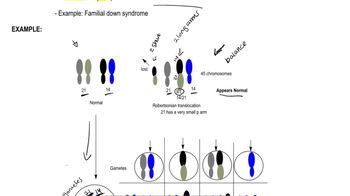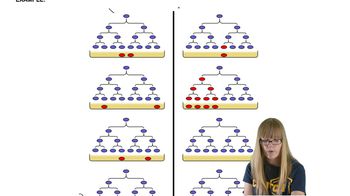Human late prophase karyotypes have about 2000 visible G bands. The human genome contains approximately 22,000 genes. Consider the region 5p1.5 through the end of the short arm of chromosome 5, which is identified on the late prophase chromosome in Figure 10.5, and assume the entire region is deleted. Approximately how many genes will be lost as a result of the deletion?
Table of contents
- 1. Introduction to Genetics51m
- 2. Mendel's Laws of Inheritance3h 37m
- 3. Extensions to Mendelian Inheritance2h 41m
- 4. Genetic Mapping and Linkage2h 28m
- 5. Genetics of Bacteria and Viruses1h 21m
- 6. Chromosomal Variation1h 48m
- 7. DNA and Chromosome Structure56m
- 8. DNA Replication1h 10m
- 9. Mitosis and Meiosis1h 34m
- 10. Transcription1h 0m
- 11. Translation58m
- 12. Gene Regulation in Prokaryotes1h 19m
- 13. Gene Regulation in Eukaryotes44m
- 14. Genetic Control of Development44m
- 15. Genomes and Genomics1h 50m
- 16. Transposable Elements47m
- 17. Mutation, Repair, and Recombination1h 6m
- 18. Molecular Genetic Tools19m
- 19. Cancer Genetics29m
- 20. Quantitative Genetics1h 26m
- 21. Population Genetics50m
- 22. Evolutionary Genetics29m
6. Chromosomal Variation
Chromosomal Rearrangements: Deletions
Problem 32g
Textbook Question
A healthy couple with a history of three previous spontaneous abortions has just had a child with cri-du-chat syndrome, a disorder caused by a terminal deletion of chromosome 5. Their physician orders karyotype analysis of both parents and of the child. The karyotype results for chromosomes 5 and 12 are shown here. Do the karyotypes of the parents help explain the occurrence of the three previous spontaneous abortions? Explain.
 Verified step by step guidance
Verified step by step guidance1
Step 1: Understand the genetic basis of cri-du-chat syndrome. Cri-du-chat syndrome is caused by a terminal deletion on the short arm of chromosome 5 (5p). This deletion can occur spontaneously or be inherited from a parent with a chromosomal rearrangement.
Step 2: Analyze the karyotype results of the parents. Look for any structural abnormalities, such as balanced translocations, inversions, or other chromosomal rearrangements, particularly involving chromosomes 5 and 12. Balanced rearrangements in a parent can lead to unbalanced gametes during meiosis, which may explain recurrent spontaneous abortions.
Step 3: Examine the karyotype of the child. Confirm the presence of the terminal deletion on chromosome 5p that causes cri-du-chat syndrome. This deletion may have arisen de novo or could be related to a parental chromosomal rearrangement.
Step 4: Correlate the findings. If one or both parents have a balanced chromosomal rearrangement (e.g., a translocation involving chromosome 5), this could lead to unbalanced gametes, increasing the risk of spontaneous abortions and potentially explaining the genetic basis of the child’s condition.
Step 5: Conclude based on the evidence. If the karyotypes of the parents show no abnormalities, the cri-du-chat syndrome in the child is likely due to a de novo mutation. However, if a parental chromosomal rearrangement is identified, it provides a genetic explanation for both the spontaneous abortions and the child’s condition.
 Verified video answer for a similar problem:
Verified video answer for a similar problem:This video solution was recommended by our tutors as helpful for the problem above
Video duration:
1mPlay a video:
Was this helpful?
Key Concepts
Here are the essential concepts you must grasp in order to answer the question correctly.
Karyotype Analysis
Karyotype analysis is a laboratory technique that examines the number and structure of chromosomes in an individual's cells. It can identify chromosomal abnormalities, such as deletions, duplications, or translocations, which may lead to genetic disorders or reproductive issues. In this case, analyzing the karyotypes of the parents and child can reveal whether chromosomal abnormalities contributed to the spontaneous abortions.
Recommended video:
Guided course

Chi Square Analysis
Cri-du-chat Syndrome
Cri-du-chat syndrome is a genetic disorder caused by a deletion of a portion of chromosome 5, leading to developmental delays, distinctive facial features, and a high-pitched cry resembling a cat's meow. Understanding this syndrome is crucial as it may indicate underlying genetic issues in the parents that could also relate to their history of spontaneous abortions, potentially due to chromosomal abnormalities.
Recommended video:
Guided course

Robertsonian Translocations
Spontaneous Abortion and Genetic Factors
Spontaneous abortion, or miscarriage, often occurs due to genetic abnormalities in the fetus, which can arise from chromosomal issues in the parents. Factors such as balanced translocations or other chromosomal anomalies can lead to embryos that are not viable. Investigating the karyotypes of the parents may reveal such genetic factors that could explain the couple's history of miscarriages.
Recommended video:
Guided course

Spontaneous Mutations
Related Videos
Related Practice
Textbook Question
348
views


